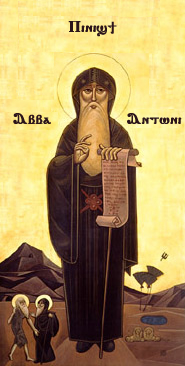
Back Woestynvaders Afrikaans آباء الصحراء Arabic اباء الصحراء ARZ Otcové pouště Czech Wüstenväter German Πατέρες της Ερήμου Greek Patroj de la dezerto Esperanto Padres del Desierto Spanish پدران صحرا Persian Pères du désert French

The Desert Fathers were early Christian hermits and ascetics, who lived primarily in the Wadi El Natrun, then known as Skete, in Roman Egypt, beginning around the third century. The Sayings of the Desert Fathers is a collection of the wisdom of some of the early desert monks and nuns.
The first Desert Father was Paul of Thebes. The most well-known Anthony the Great, who moved to the desert in 270–271 and became known as both the father and founder of desert monasticism. By the time Anthony had died in 356, thousands of monks and nuns had been drawn to live in the desert following Anthony's example, leading his biographer, Athanasius of Alexandria, to write that "the desert had become a city."[1] The Desert Fathers significantly influenced the development of Christianity.
The desert monastic communities that grew out of the informal gathering of hermit monks became the model for Christian monasticism, first influencing the Coptic communities these monks were a part of and preached to.[2] Some were monophysites[2] or believed in a similar idea.
The eastern monastic tradition at Mount Athos and the western Rule of Saint Benedict were both strongly influenced by the traditions that began in the desert. All of the monastic revivals of the Middle Ages looked to the desert for inspiration and guidance. Much of Eastern Christian spirituality, including the Hesychast movement, has its roots in the practices of the Desert Fathers. Even religious renewals such as the German evangelicals and Pietists in Pennsylvania, the Devotio Moderna movement, and the Methodist Revival in England are seen by modern scholars as being influenced by the Desert Fathers.[3]
- ^ Chryssavgis 2008, p. 15.
- ^ a b Olupona, Jacob K. (2014). African Religions: A Very Short Introduction. Oxford: Oxford University Press. p. 90. ISBN 978-0-19-979058-6. OCLC 839396781.
- ^ Burton-Christie 1993, pp. 7–9.
© MMXXIII Rich X Search. We shall prevail. All rights reserved. Rich X Search